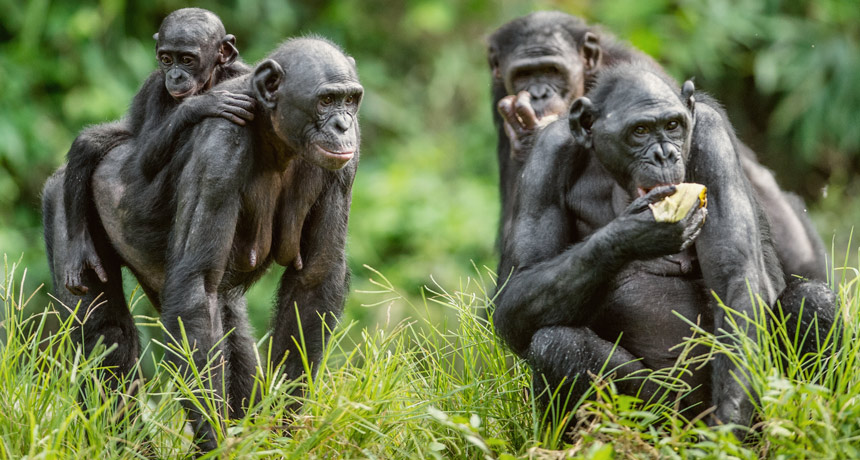About this time last year, I faced an all too familiar problem for researchers in our field — I wanted access to specimens that just weren’t readily available. You see, last spring I was developing my dissertation project looking at the effect of habitual activity on the attachment site region between muscle and bone. This project would require muscle functional data from primates of diverse genetic and locomotor backgrounds, including some rather rare species. Of course, ever the optimist, I began my search with the most elusive of my targets: the bonobo.
Though they share the same genus designation, much less is known about bonobos than their counterparts, the common chimpanzee. They certainly have a reputation, however, as smaller-bodied, uniquely social (read: sexually gregarious) apes, making them intriguing if not wholly practical subjects. In this case, I was interested in bonobos both because of their reputed increased proficiency at bipedal walking and because of their genetic proximity to Pan troglodytes, having speciated only after the formation of the Congo River intervening their habitats some 1.5-2 million years ago. This compact timeline indicates that comparisons between the bonobo and the chimpanzee may be usefully applied to models looking at evolutionary change between modern humans and our nearest ancestors. Indeed, I’ve no doubt that bonobos would be more intensely studied were they 1.) more numerous and 2.) more accessible.
As it stands, studying bonobos requires either traveling to the tiny part of the Congo Basin wherein they live, or visiting one of the few zoos around the world housing a colony of them. The latter is generally a better (and more hospitable) place to look for dissection work, though zoos can be understandably reluctant (or simply unable) to provide researchers with the animal of interest after its death. With that in mind, I teamed up with Dr. Rui Diogo from Howard University to entice zoos with one broad, impactful goal: to make an anatomical atlas for the bonobo, the like of which did not previously exist for this species. Having scoped out the world’s zoos for the presence of bonobos, I first contacted the Royal Zoological Society of Antwerp (KMDA), who came back to Rui and me with an interesting proposition.
The KMDA maintains the Planckendael Zoo, a sprawling crop of land just outside the bustle of Antwerp proper containing an assortment of animals from the American bison to the quintessentially Australian koala. Planckendael is also home to Belgium’s stock of bonobos, where they are well looked-after by attentive keepers. In the sad event of a death, Planckendael happens to do something unique and admirable — they store the bonobo with the hope of future scientific inquiry. When my own email reached the zoo, they had amassed a number of specimens over the span of a decade and, after much deliberation, decided that the time was right to organize a collaboration.
The plans seemed to come together all at once, a handful of weeks before the designated start date. Institutions from around the world (George Washington University, Howard University, CUNY, The University of Kentucky, the University of Valladolid, the University of Barcelona, the University of Leuven and the Max Planck Institute for Evolutionary Anthropology) came together for a two-week span that went by in a mere blink. Every day started with an orientation from Dr. Bernard Wood promptly at 9 am, and we frequently stayed well into the next before sleepily shuffling back to our hotels. We had two adult bonobos to get through, after all, as well as three infants and a fetus, in addition to two enormous chimpanzees and one particularly adorable siamang named Herbie. It was, in a word, a madhouse, but a glorious and productive chaos in which I was able both to collect all of my muscle data as well as connect with international colleagues.
By the end of the allotted time, I was exhausted in every sense of the word, but I’d managed to get my hands on three of the unlikeliest of specimens. It gives me hope that I’ll be able to find sources for the other primates that I need for my dissertation, and I’m very thankful to Royal Zoological Society of Antwerp for affording all of us the opportunity to work on their specimens. In return, we’ve collected photos for a photographic atlas that will open up the world of this rare and fascinating ape to the rest of the world.
I’d like to specifically acknowledge Sandra Nauwelaerts for her patience and lead in organizing this endeavor, the Royal Zoological Society of Antwerp for the specimens and the University of Antwerp for kindly lending us lab space for the dissections. This also wouldn’t have been possible without Dr. Rui Diogo, nor would it have been nearly as enjoyable without my colleagues Dr. Ashley Hammond, Edwin Dickinson, Brian Shearer and the saintly Heidi Vollrath.


